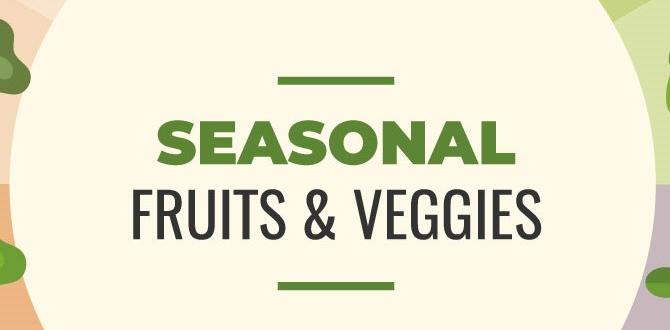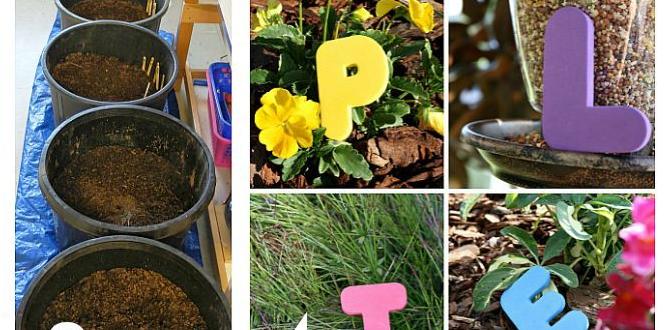Have you ever watched a tiny seed grow into a big plant? It’s amazing! Gardening activities for kids can turn this wonder into an adventure. Imagine planting seeds, watering them, and watching life unfold. It’s like magic in your own backyard.
Many kids love dirt and the outdoors. Why not combine both? Gardening is a fun way to explore nature and learn. Did you know that digging in the soil can help kids feel calmer and happier? It’s true! Working in the garden helps them to focus and grow.
Picture your child getting their hands muddy while planting flowers or vegetables. Isn’t that a joyful sight? With gardening, they can create their own tiny world. Each activity teaches them something new and keeps them active.
From making seed bombs to creating a butterfly garden, the options are endless. Gardening gives children a chance to be creative. Plus, they get to enjoy delicious fruits and veggies later! So, why not start a gardening adventure today? Your little one will thank you with a big smile.
Fun Gardening Activities For Kids To Enjoy Outdoors
Gardening Activities for Kids
Gardening is a fun and exciting way for kids to connect with nature. Engaging in gardening activities like planting seeds or watering plants can teach children about responsibility. Imagine their joy when they see a sprout grow! Kids can learn about different plants and even create a mini garden at home. Did you know that gardening helps develop fine motor skills too? These activities spark curiosity and foster a love for the outdoors, making learning enjoyable!Benefits of Gardening for Children
Enhances physical health and motor skills. Promotes emotional wellbeing and environmental awareness.
Gardening offers many benefits for children. It helps them stay active, making their bodies stronger and improving motor skills. Kids dig, plant, and water, which builds muscles and coordination. Gardening also makes them feel happy and relaxed. Seeing plants grow can boost their confidence. Furthermore, it teaches them to care for the earth, promoting environmental awareness. They learn how to protect nature and understand the importance of plants in our world.
How does gardening benefit children’s health and wellbeing?
Gardening improves children’s physical health by promoting exercise and developing motor skills. It also supports emotional wellbeing by reducing stress and increasing happiness. Kids learn about the environment and how to care for it, fostering a sense of responsibility.
Key Benefits:
- Improves physical fitness
- Boosts confidence and self-esteem
- Increases awareness of nature
- Encourages teamwork as kids work together
Simple Gardening Projects for Beginners
Ideas for starting with potted plants and indoor gardens. Instructions for creating small outdoor gardens.
Starting with plants can be fun and easy! You can create a small indoor garden with potted plants. Choose colorful pots that can brighten up any room. Some great options are succulents and herbs. They are low maintenance and bring smiles! For outdoor fun, pick a small patch in your yard. Plant flowers or veggies. They grow fast and taste even better. Here’s a simple table to get you started:
| Project | Materials Needed | Steps |
|---|---|---|
| Potted Plants | Pot, soil, plant | Fill pot with soil, place the plant, water it. |
| Small Outdoor Garden | Seeds, soil, garden tools | Till soil, plant seeds, water them daily. |
Remember, gardening is like a magic show. You plant, and then—boom!—growth appears. So grab your little gardening hat and let’s dig in!
Seasonal Gardening Activities to Try
Spring planting projects: flowers and vegetables. Fall harvesting and preparation for winter.
Spring is the perfect time to roll up those sleeves and get your hands dirty! Kids can plant colorful flowers and yummy vegetables. Imagine a garden bursting with tasty tomatoes or cheerful sunflowers. In fall, it’s time for the exciting harvest. Children can gather fruits and veggies while pretending they are explorers. Plus, preparing the garden for winter is like making a cozy blanket for the plants. Who knew gardening could be so much fun?
| Season | Activities |
|---|---|
| Spring | Plant flowers and vegetables |
| Fall | Harvest and prepare for winter |
Educational Aspects of Gardening
Connecting gardening with science and biology lessons. Incorporating math skills through measurement and planning.
Gardening is a fun way for kids to learn. They can explore science as they watch plants grow. Photosynthesis, the way plants make food using sunlight, is an exciting topic to discover. Kids can also practice math skills by measuring soil and spacing plants. This makes planning their garden a hands-on math lesson. Each plant teaches them about life cycles, from seed to bloom. Isn’t nature amazing?
How does gardening help with learning?
Gardening connects with science and math. Kids can see real-life examples of what they learn in class. Measurements for planting help improve their math skills too!
Topics kids explore in gardening:
- Life cycles of plants
- Soil types and nutrients
- Measurement skills for planting
- Weather effects on growth
Gardening Themes to Inspire Creativity
Themed gardens: fairy gardens, vegetable patches, and flower beds. Encouraging storytelling and imagination through gardening.Gardening can be a wonderful adventure! You can create magical spaces like fairy gardens, colorful flower beds, and tasty vegetable patches. Kids can use their imaginations to tell stories while they dig and plant. The garden becomes a canvas for creativity, where each flower could hide a fairy or where veggies become heroes in a story. This helps children learn and have fun at the same time!
What themes can kids explore in gardening?
Kids can explore many fun themes like:
- Fairy gardens with tiny houses and miniatures.
- Vegetable patches filled with their favorite snacks.
- Bright flower beds that attract butterflies.
Themed gardens spark joy and creativity, encouraging kids to think outside the box while enjoying nature.
Community Gardening Initiatives for Families
Benefits of community gardening for children. How to find or start a community garden.
Community gardens are great for families. They help kids learn about nature and teamwork. Children can grow vegetables and flowers, which boosts their creativity. They also develop new friendships when they work together. Here are some easy ways to find or start a community garden:
- Check with local parks or schools.
- Ask neighbors if they want to join.
- Look for online groups focused on gardening.
Joining a community garden can make gardening fun while teaching valuable skills!
What are the benefits of community gardening for kids?
Community gardening helps kids learn responsibility and patience. It allows them to see the results of their hard work, boosting their confidence.
How can families start a community garden?
Families can start a community garden by forming a group and finding a suitable location. They can then plan what to grow together!
Challenges and Solutions in Kids’ Gardening
Common obstacles: pests, weather, and soil issues. Tips for overcoming gardening challenges with children.
Gardening with kids can be fun, but it has its hiccups! Common problems include pesky pests, unpredictable weather, and picky soil. To tackle these challenges, keep a few tricks up your sleeve. For pests, you can create natural repellents using soap or garlic. If the weather is gloomy, consider starting an indoor garden. Finally, if the soil is stubborn, mix in compost to give it a boost. Remember, every garden has its challenges, but with teamwork, you can dig through anything!
| Challenge | Solution |
|---|---|
| Pests | Create natural repellents. |
| Weather | Start an indoor garden. |
| Soil quality | Add compost for improvement. |
Gardening Beyond Plants: Exploring Ecosystems
Incorporating animal habitats and pollinators in gardening activities. Understanding composting and soil health through handson activities.Gardening isn’t just about plants; it’s like inviting a whole party of critters! Think of animal habitats and how friendly bees help flowers grow. With fun activities, kids can create tiny homes for worms or butterflies. Plus, composting teaches them about soil health, turning kitchen scraps into gold! It’s like magic, but with food waste. Feeling curious? Check out this table!
| Activity | Fun Fact |
|---|---|
| Build a Bug Hotel | Bees can visit 2 million flowers in a single day! |
| Composting Scraps | Worms can consume half their body weight in food daily! |
| Create a Butterfly Garden | Butterflies taste with their feet. Talk about a unique talent! |
With these activities, kids can learn, have fun, and become mini eco-experts. Their garden won’t just grow; it will buzz with life!
Conclusion
Gardening activities for kids are fun and educational. They help develop responsibility and appreciation for nature. You can start with simple tasks like planting seeds or watering plants. These activities also encourage teamwork and creativity. Remember to explore different plants and garden designs together. Keep learning! Check out books or websites for more gardening tips and ideas. Happy gardening!FAQs
What Are Some Easy-To-Grow Plants Or Vegetables That Kids Can Help Plant In A Garden?You can grow fun plants like radishes, lettuce, and sunflowers. These seeds sprout quickly and are easy to care for. You can also plant beans and peas, which climb and can be really cool to watch. Herbs like basil and cilantro are simple to grow too. Gardening together is a great way to learn and have fun!
How Can Gardening Activities Be Integrated Into A Child’S Learning Experience About Nature And Science?We can use gardening to learn about nature and science in fun ways. You can plant seeds and watch them grow. This shows how plants need soil, water, and sunlight. We can also explore bugs and animals that visit our garden. It helps us understand ecosystems and how living things work together.
What Fun Gardening Tools And Accessories Are Suitable For Young Children To Use?You can use small shovels and rakes that fit in your hands. Colorful watering cans make it fun to water plants. There are also cute gloves that help keep your hands clean. You might like using seed markers to label your plants and garden space. Don’t forget to get a bright apron to keep your clothes safe while you garden!
How Can Families Encourage Kids To Take Responsibility For Caring For Their Garden Over The Growing Season?We can help kids take care of the garden by giving them jobs. You can let them water the plants or pull out weeds. Make it fun by setting a schedule or using colorful tools. Celebrate their hard work by eating the yummy veggies we grow together! This helps them feel proud and responsible.
What Creative Gardening Projects Can Kids Participate In To Foster Teamwork And Community Involvement?You can start a community garden together. Everyone can pick a type of plant to grow. You can also create fun signs to label each plant. Another idea is to make a flower pot painting day, where you decorate pots for the garden. Working together helps everyone feel proud and makes new friends!







